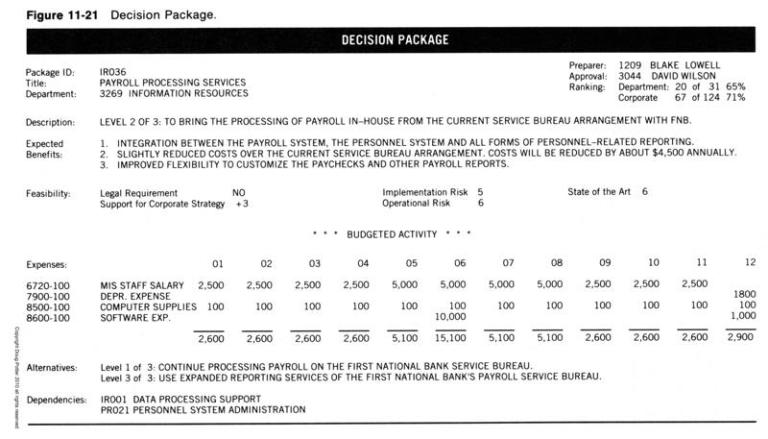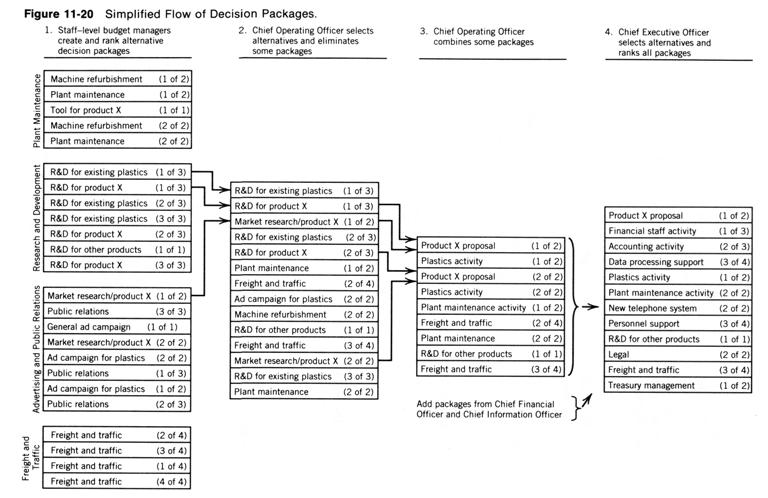CREATING THE DECISION PACKAGES
Each decision package describes a unit of activity that may become a component of the approved budget. They contain information about the cost, benefits, intangible elements, and risks of the activity. Figure 11-21 shows a decision package created with the budgeting system's assistance.

Decision Package Entry. For the budgeting system to accommodate all of the decision package information shown in Figure 11-21, it must retain textual as well as fixed length information (such as package ID, title, department, preparer, ranking, and feasibility indicators). Generally speaking, the more information, the more complex the automated system becomes. However, the system must not necessarily accommodate all of this information in order to support zero-base budgeting. A less complex approach may involve eliminating much of the text and possibly some of the other attributes that help qualify the decision packages.
Although this means that each package will be further explained by a manually prepared document, it results in a less complex automated system. Even with this trimmed down approach, it is important to retain the budget information by account on each decision package and to preserve a limited number of data elements that can be used for ranking, sorting, and selecting the decision packages.
Because many decision packages often closely resemble one another, the system should allow a budget manager to create a new package by copying an existing one. This reduces the time and effort required for creating decision packages.
Combining. Often a budget manager will combine a set of decision packages that is dependent on one another into a single new package. This relieves upper level management from the burden of reviewing so many detailed decision packages and can reduce the overall time required for ranking and analysis. The third step of Figure 11-20 shows two decision packages for "Product X" being combined to form a new one.
The system should expedite this process by combining the budgeted account activity from several source decision packages into one new package. The system may allow textual and header information to be copied from a single, designated package into the new one and then revised as necessary.
Relationships among the Decision Packages. The system should record dependencies among decision packages, allowing two or more packages to specify that they are dependent on one another. In Figure 11-20 the marketing, research and development, and production decision packages for a certain support level of the new "Product X" are all mutually dependent. If the chief operating officer is going to cut any one of these decision packages, he must cut them all. A key benefit to automating zero-base budgeting is that the system can track these dependencies and, in the ranking process, make sure that all dependencies are respected when decision packages are collectively either disapproved or approved.

In zero-base budgeting the budget managers prepare alternative decision packages for a single activity. For example, "machine refurbishing" may be presented as two alternatives: "1 of 2" and "2 of2." This allows the managers to examine and rank different levels of the activity that might exist. The first alternative for "machine refurbishment" might be the bare minimum level of expenditure required to keep the machines operational for the next year; the second might include a higher level of refurbishing that helps extend their overall lifetime and helps improve the quality of products they produce. Each decision package represents a different level of effort or funding required for the particular project.
Thus, a particular decision packages may be mutually exclusive: only one will be ultimately selected. The decision package in Figure 11-21 is one of three alternative decision packages. The bottom of this package shows the titles of the other alternative decision packages:
• Level 1 of 3: Continue processing payroll on the First National Bank Service Bureau.
• Level 3 of 3: Use expanded reporting services of the First National Bank's payroll service bureau.
Just as the automated zero base budgeting system can help track dependencies among the decision packages, it should also track these mutually exclusive relationships, making sure that only one alternative decision packages can be selected.
NEXT MONTH'S TOPIC: SELECTING THE DECISION PACKAGES
Material in this chapter has been adapted and reprinted with the permission of Warren, Gorham & Lamont, Inc., from Chapter 43, “Automated Budget Systems,” in Budgeting and Profit Planning Manual, 2nd edition, by James D. Willson. Copyright 1983, 1989 by Warren, Gorham & Lamont, Inc. 210 South Street, Boston, MA 02111. All rights reserved.